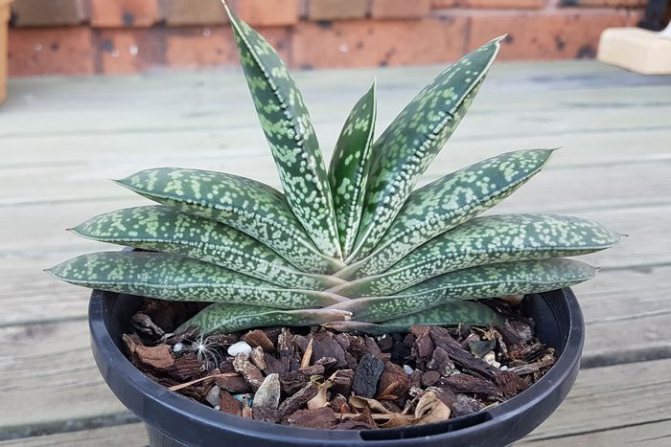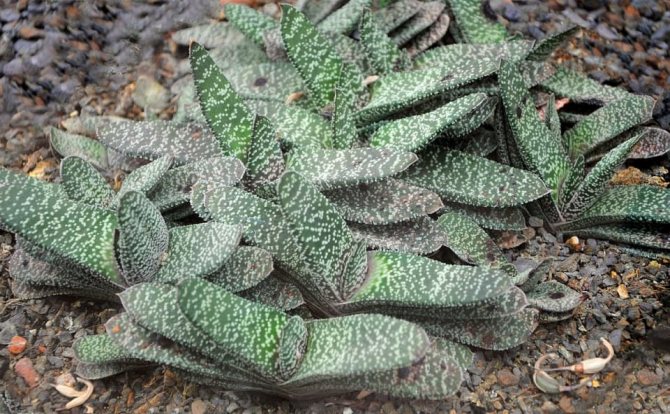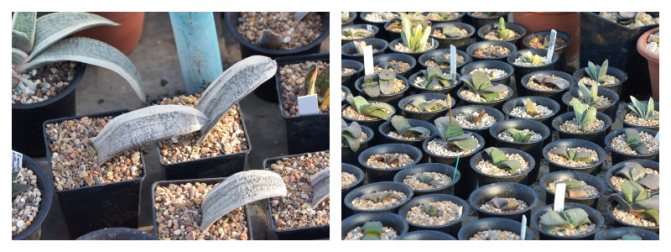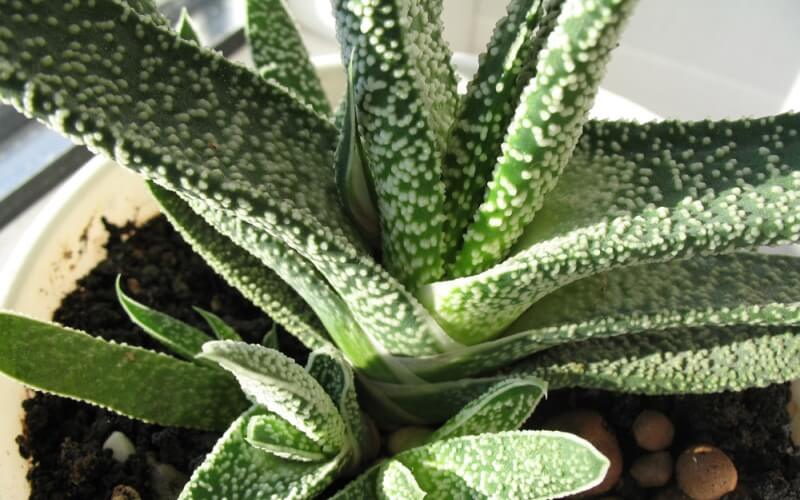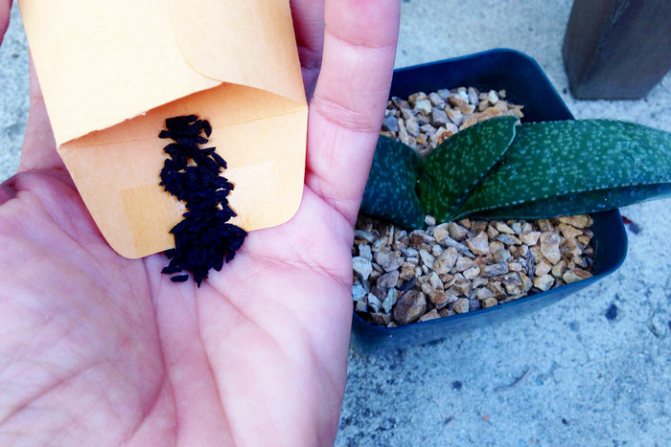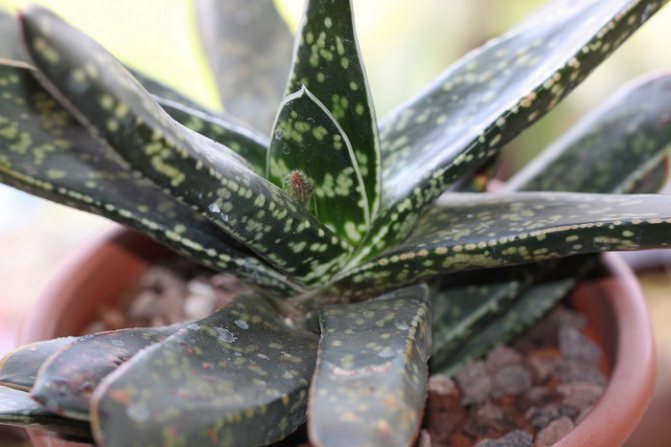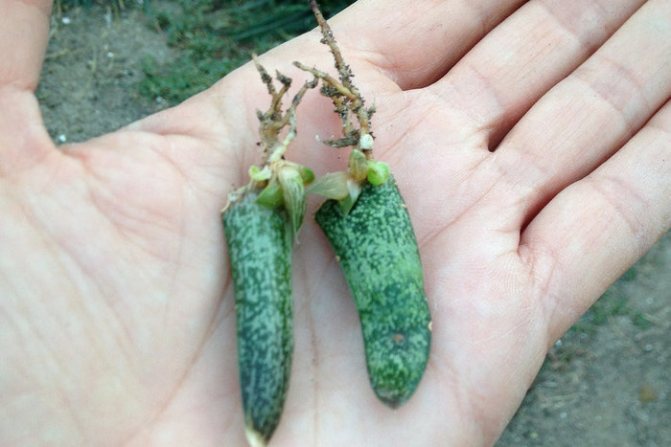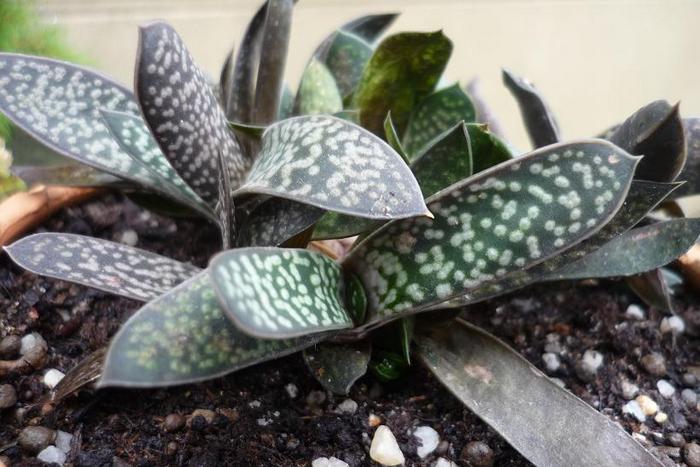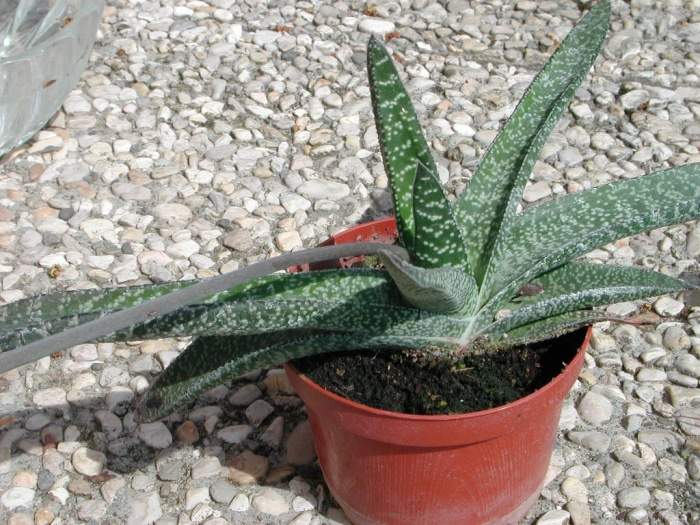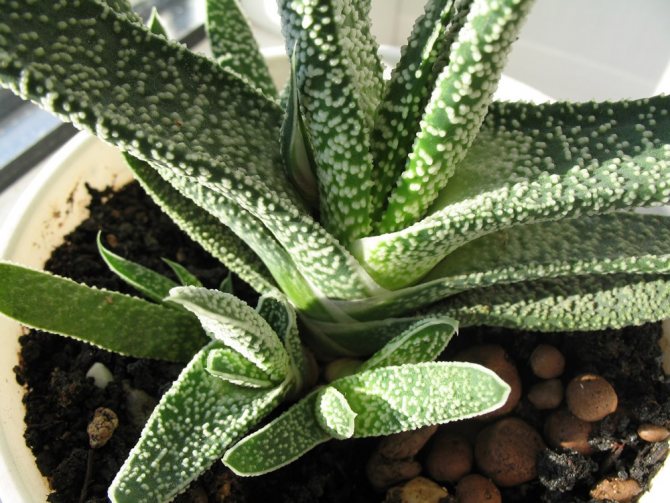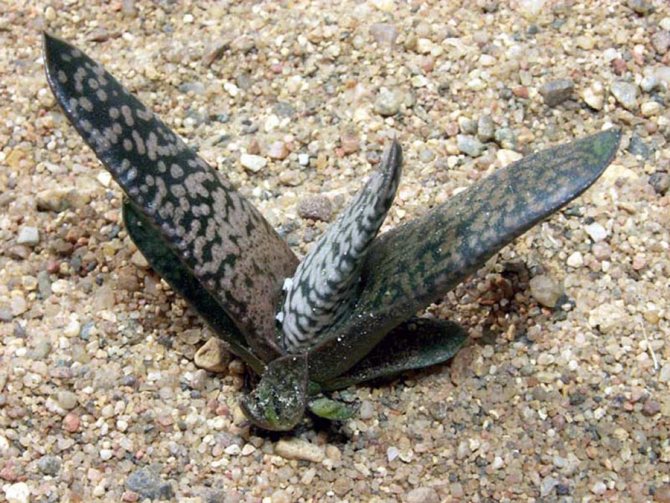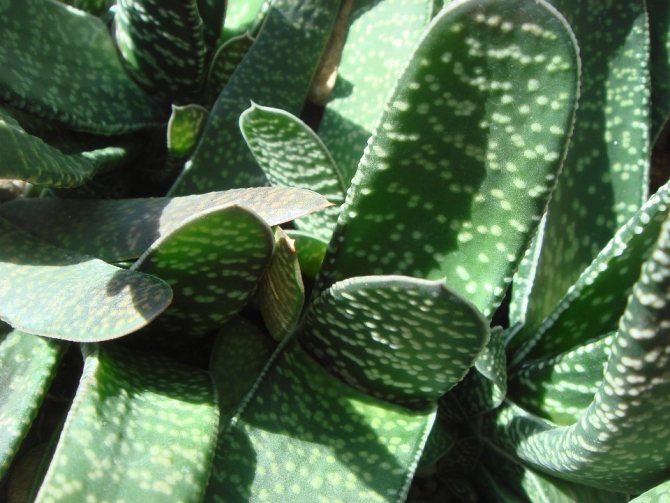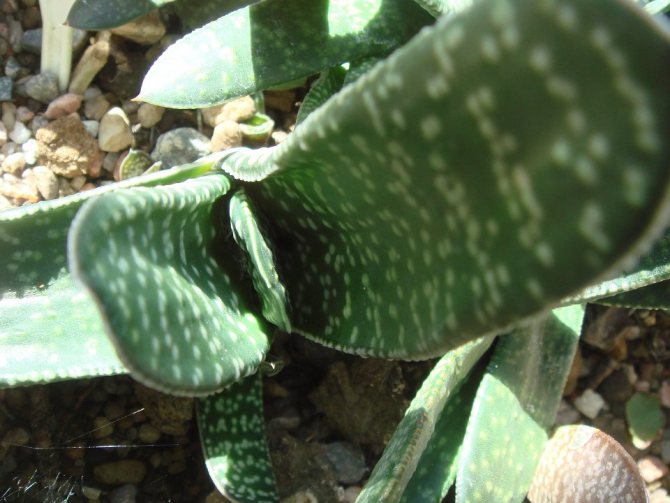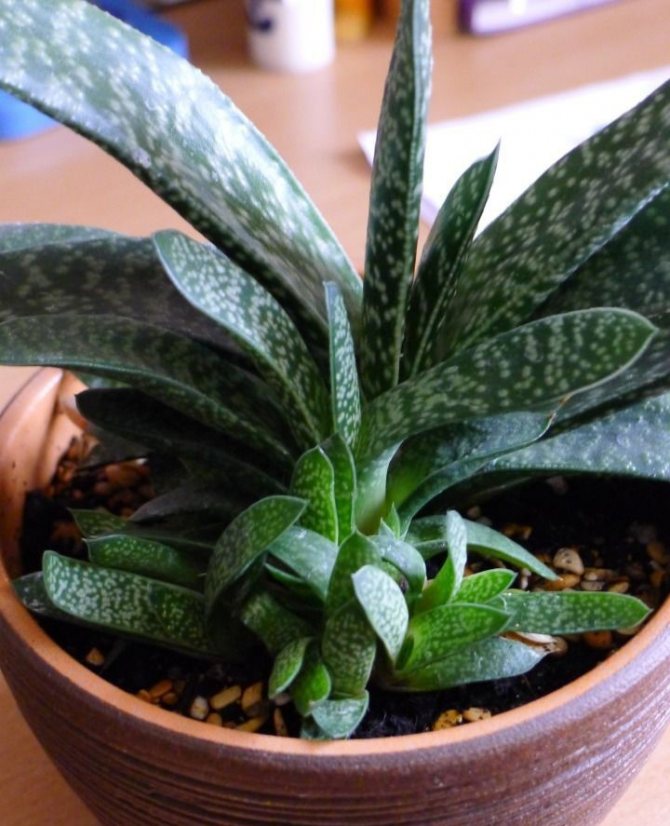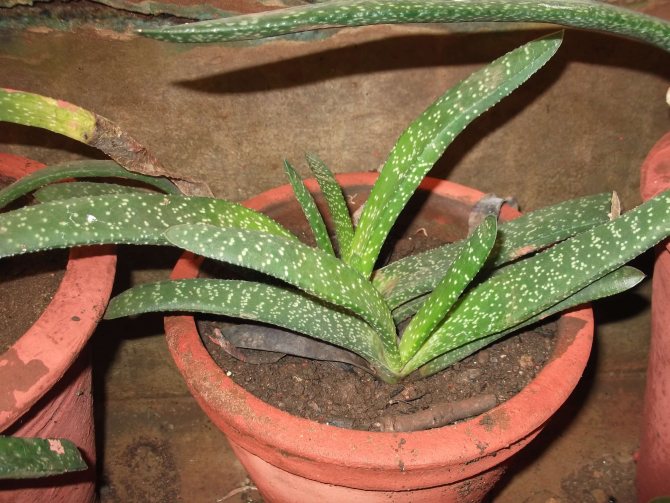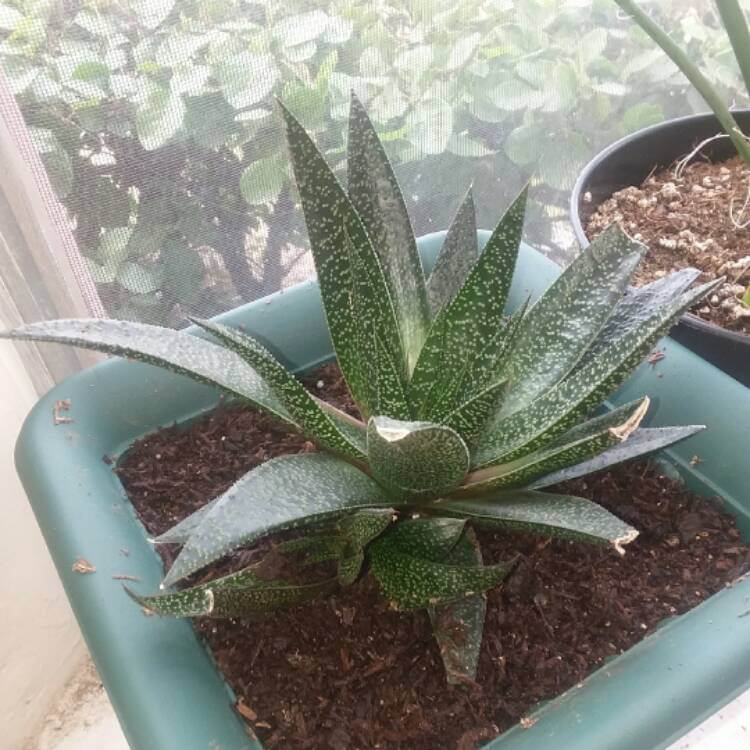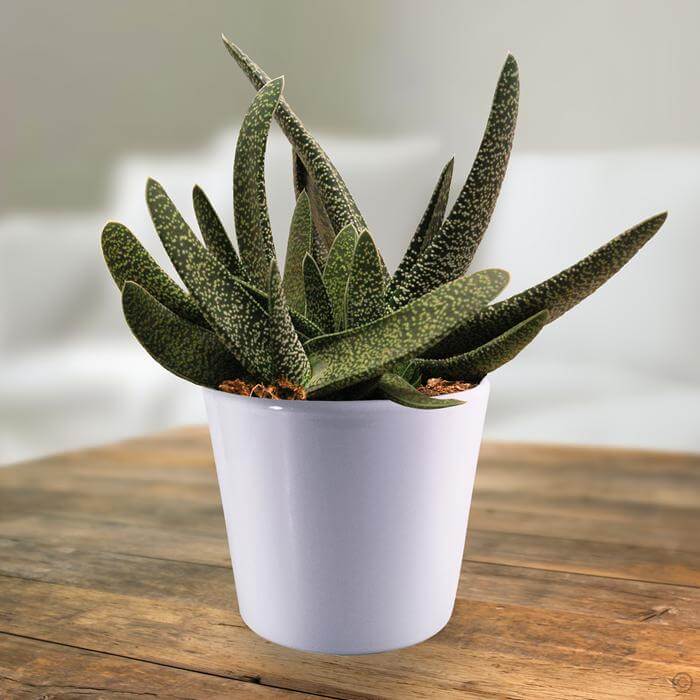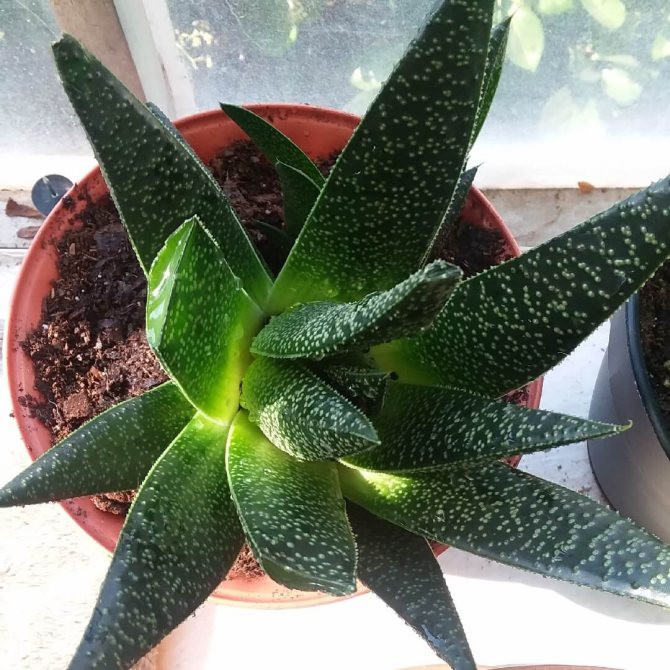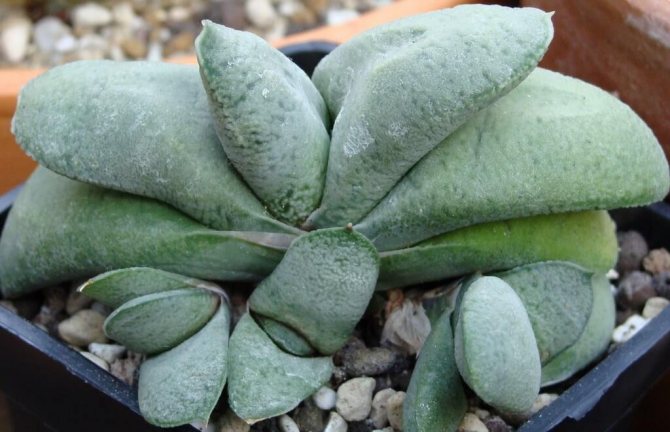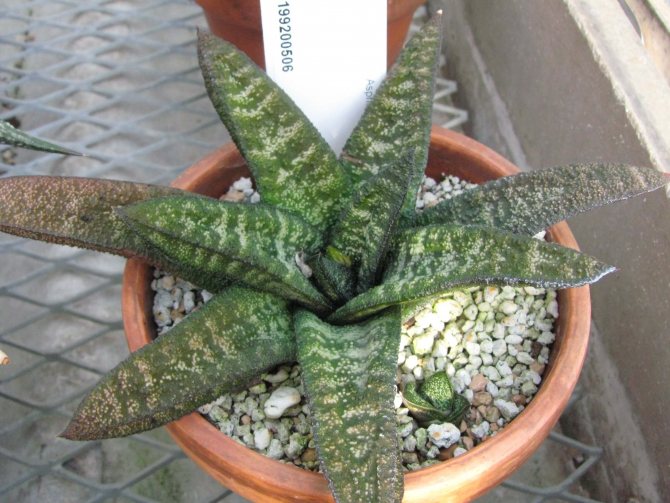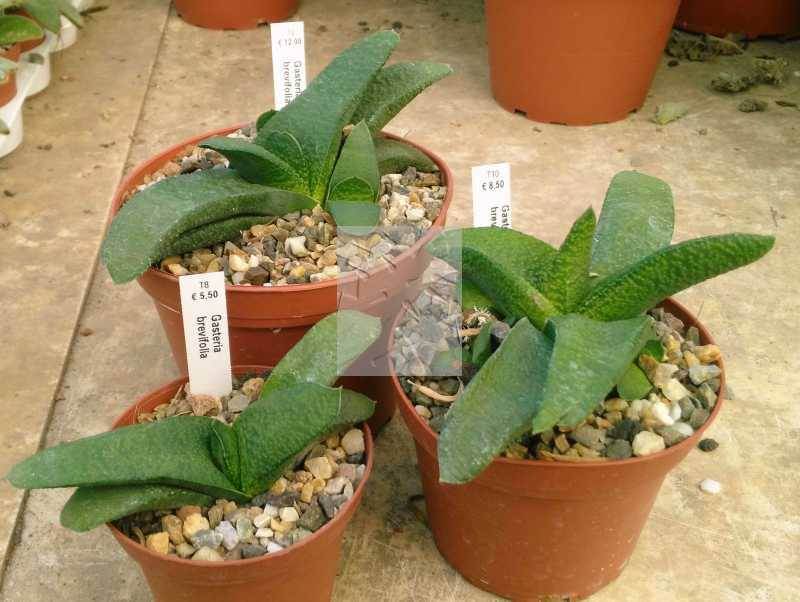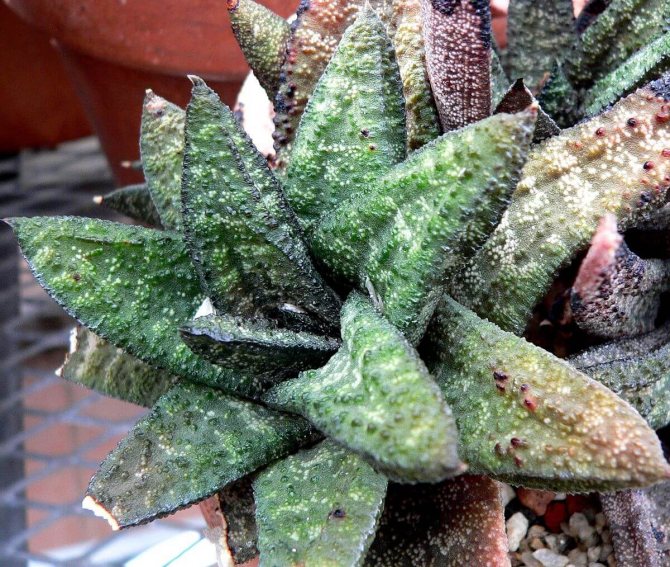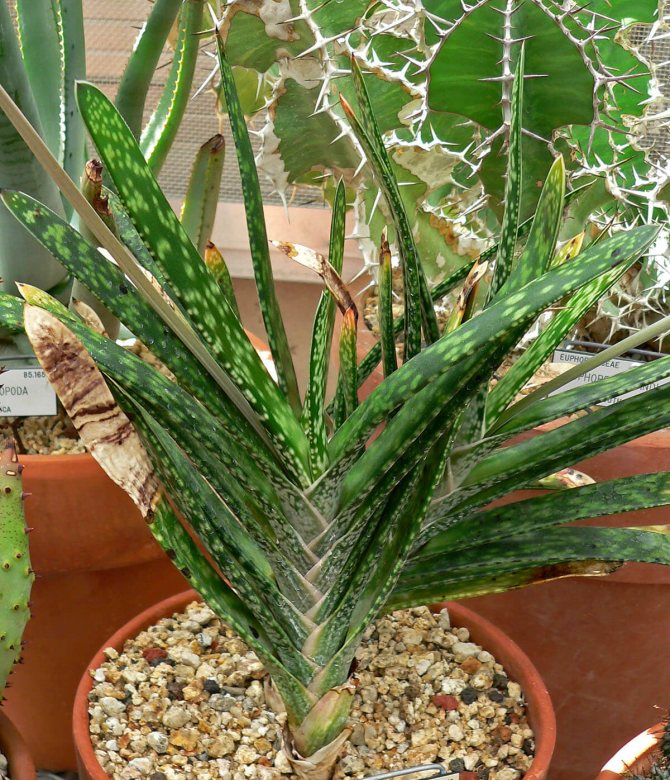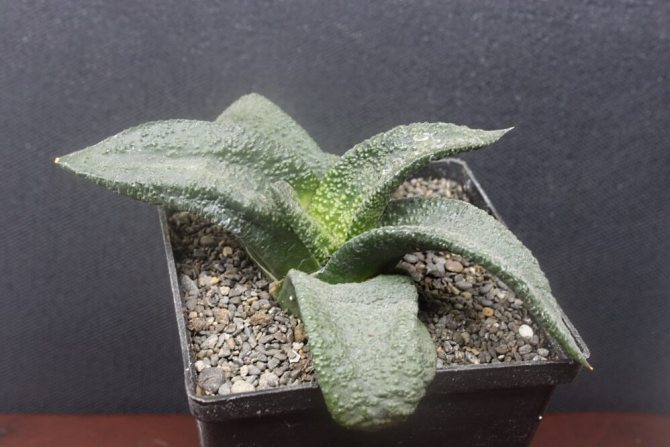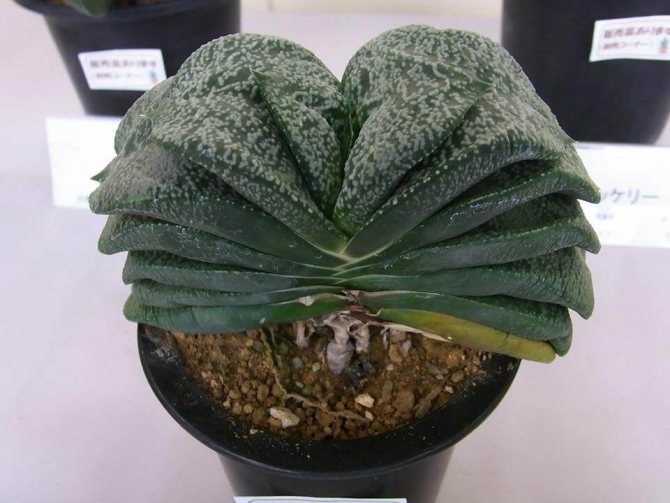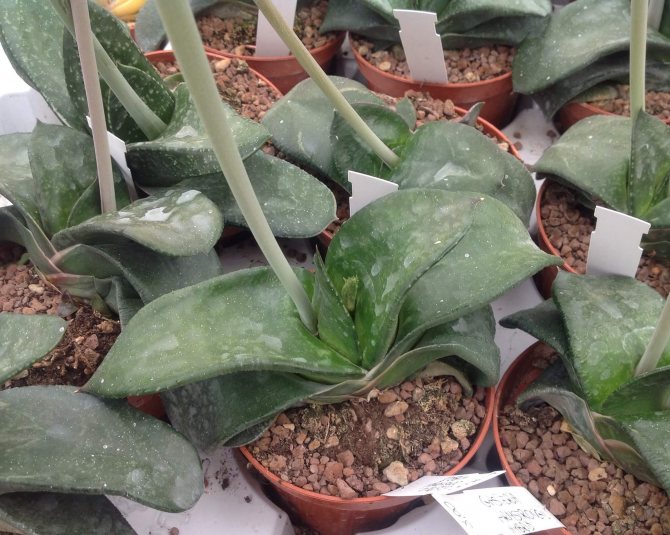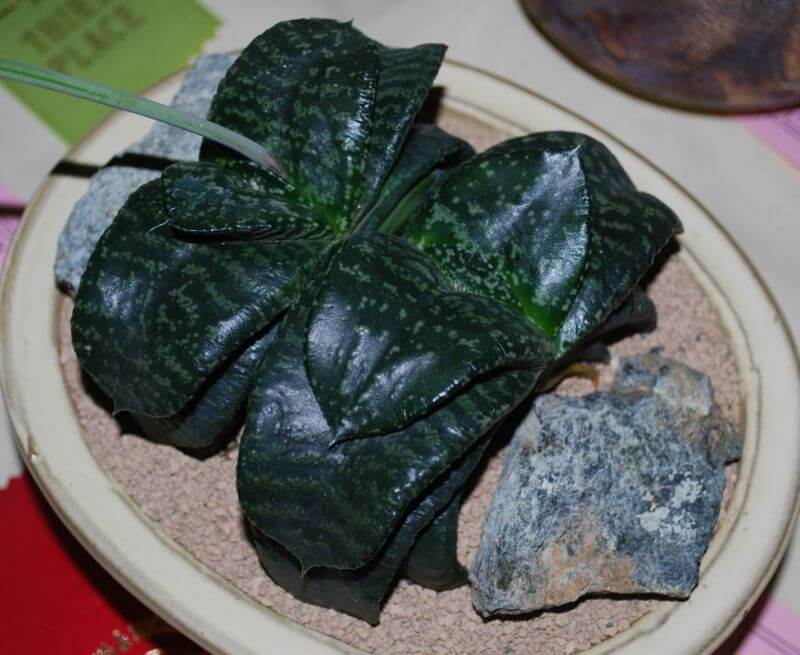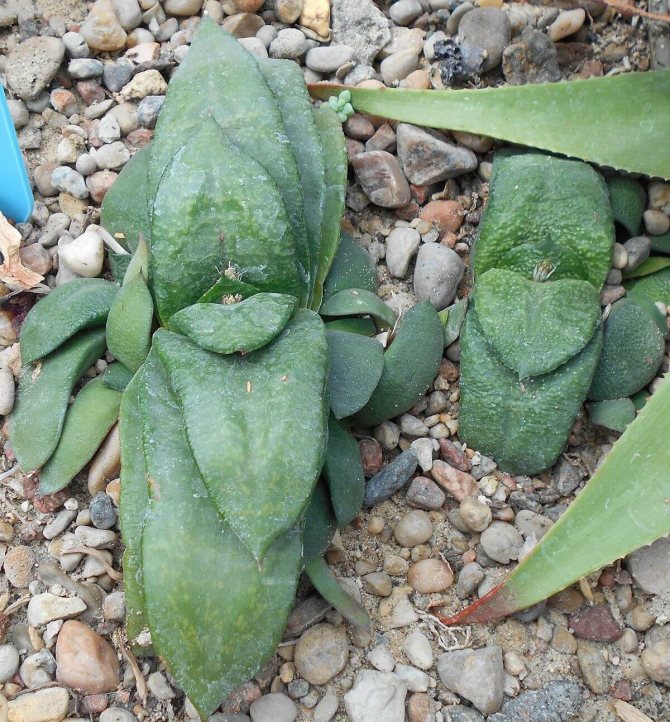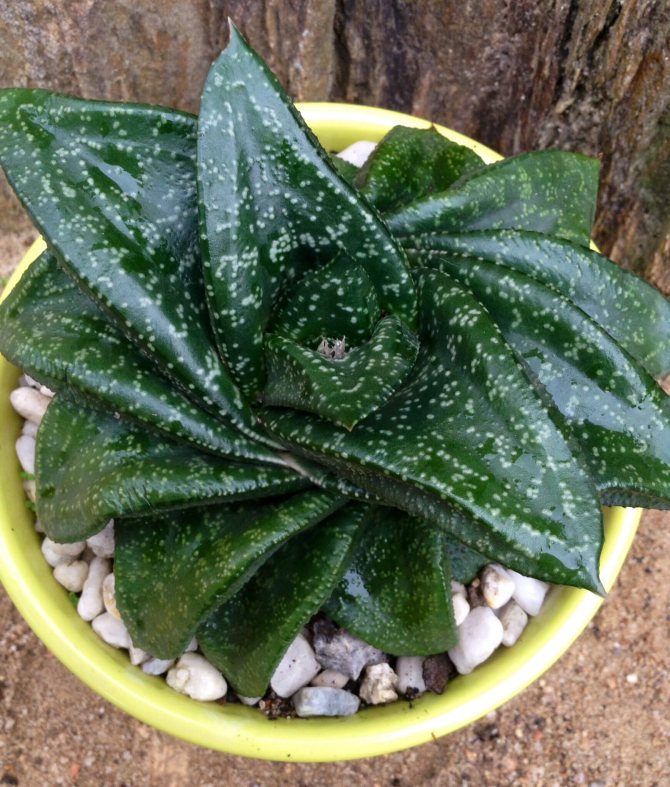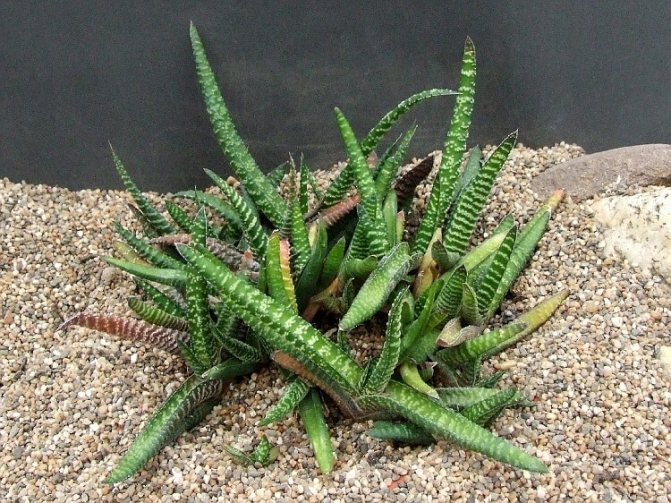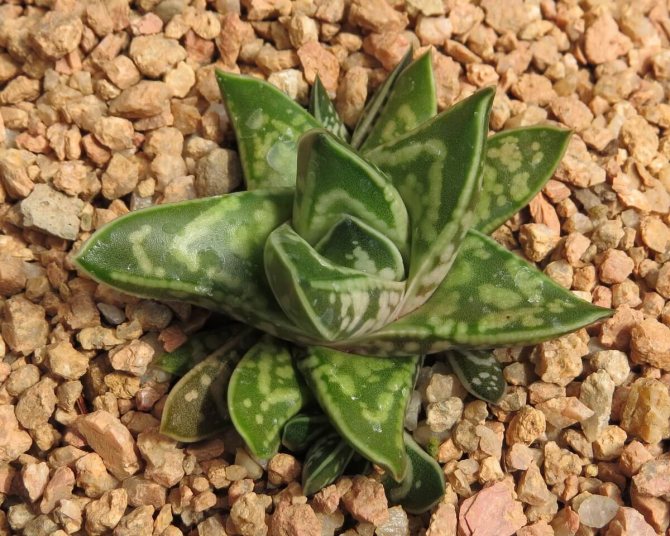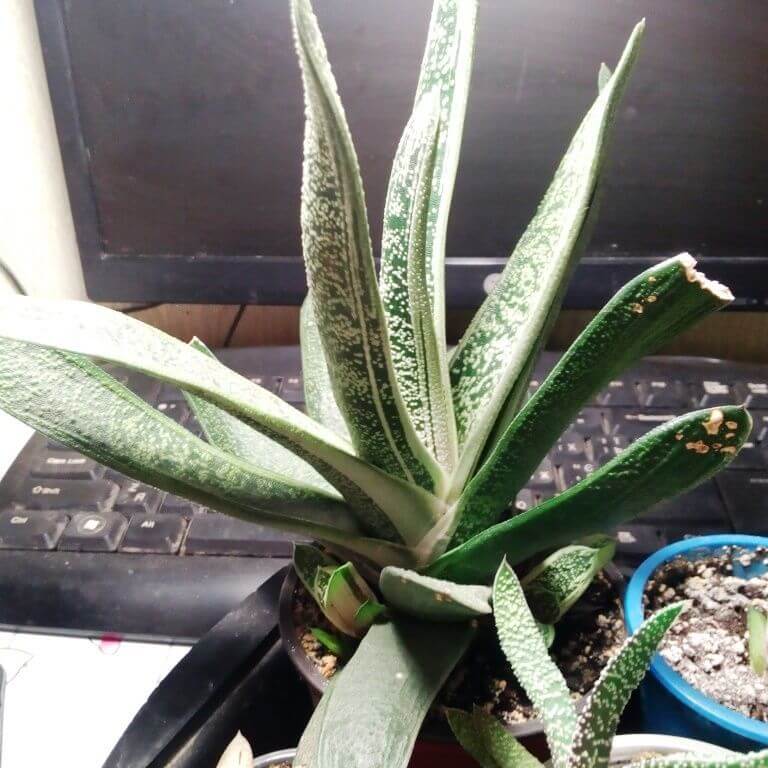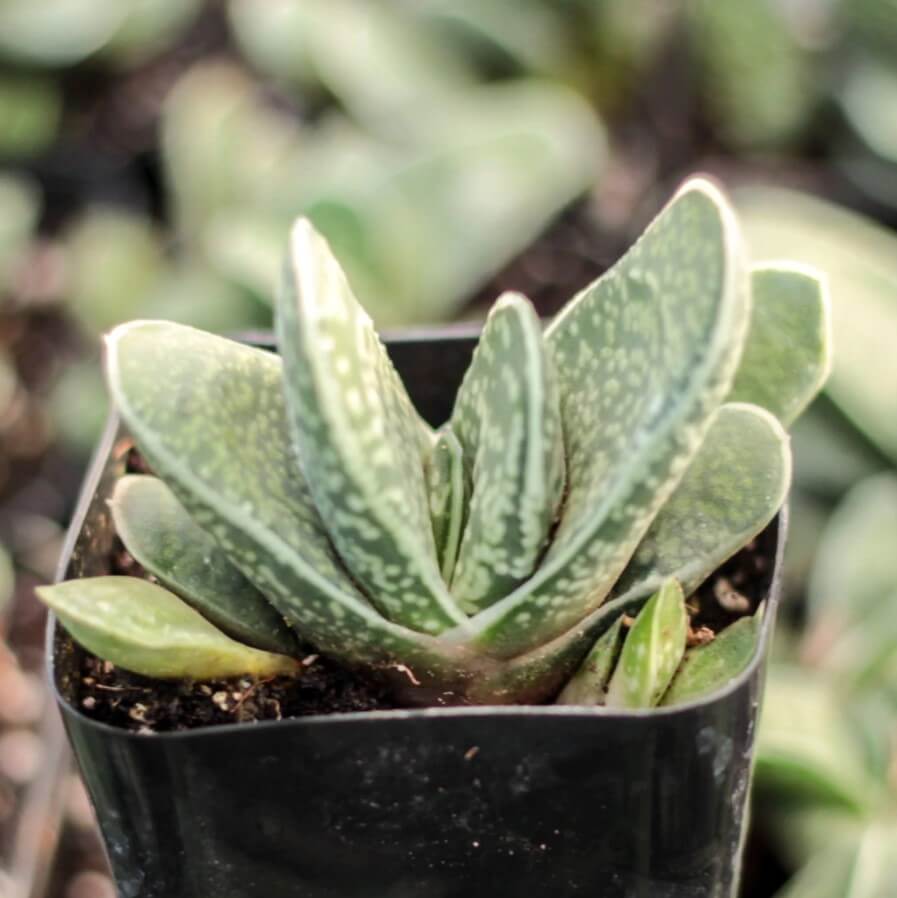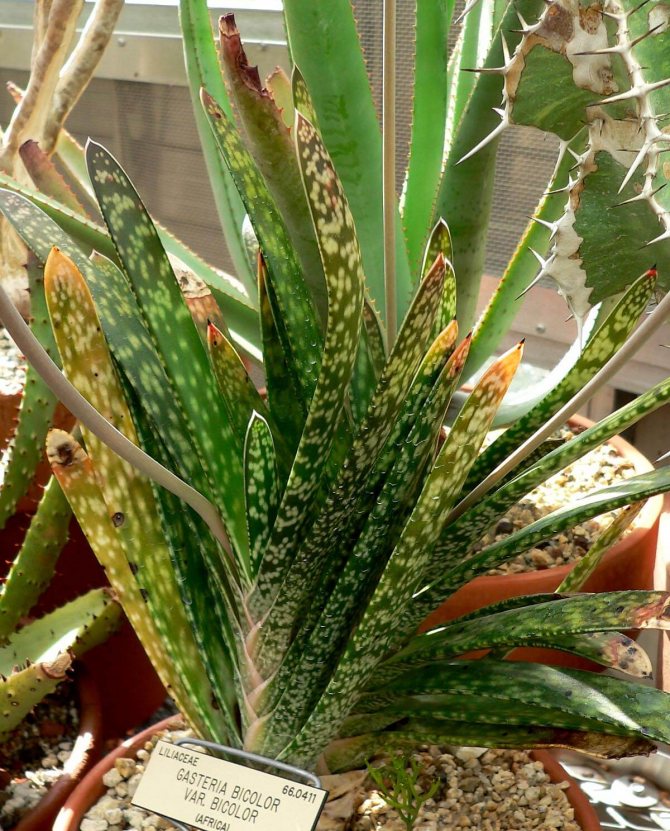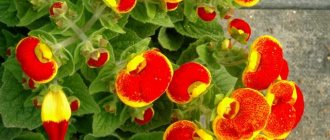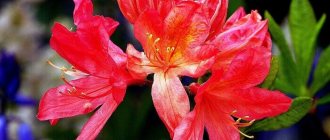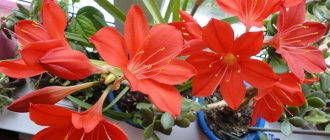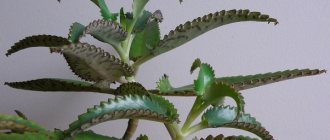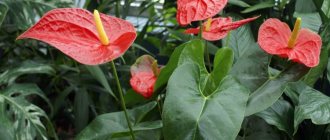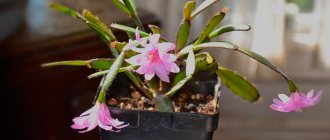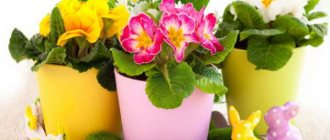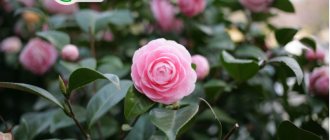Gasteria is native to the hot, arid rocky deserts of South Africa. Scientists have discovered more than 80 species of it in nature. But only a few have taken root as an ornamental plant.
Gasteria is a succulent, like many desert plants, forced to accumulate water in the leaves "in reserve", like a camel. It belongs to the asphodelic family and is related to the aloe.
Gasteria is a perennial plant with fleshy, tongue-shaped leaves. Its scientific name is associated with the shape of the flower - "pot-bellied vessel", but the folk name - with the shape of the leaf - "language of the lawyer." The leaves vary in color, from dark to light green, depending on the species. Representatives of its different species are covered with whitish spots or pimples, but each of them may have its own pattern on the leaves.
Find out more about the Washingtonia palm tree at home, the intricacies of care and maintenance.
Did you know about such a flower as heliotrope?
Gastria flowers vaguely resemble bells - they have fused petals in the shape of a pot-bellied bottle. Their color is usually pink-cream, white, green, orange and red. They grow on a long peduncle - up to 70 cm.
Description of the plant
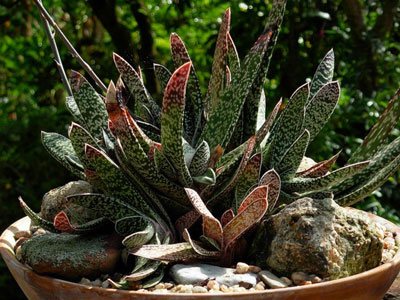
In its natural environment, the habitats of succulents are rocky slopes and valleys of Africa, the Mediterranean, and Central Asia.
Resistance to changing temperature conditions and undemanding care made it a popular indoor floweroften found on window sills.
Often the culture is confused with haworthia and aloe, which are also representatives of the asphodelic.
Gasteria has a strongly shortened stem, which is covered by rigid foliage located in two rows, growing in a spiral. Dark green leaf plates of various shapes are decorated with a pattern of various spots or stripes across the entire surface of the fleshy base. Depending on the variety, the leaf surface can be rough or smooth, as well as flat or slightly concave. The length of the leaf with a pointed or rounded upper part varies from 4 to 25 cm, while the width does not change.
Succulent flowering occurs when the plant throws out an arrow 40-100 cm long after each row of leaf plates. The peduncle is crowned with a racemose inflorescence, consisting of yellow, green or orange flowers in the form of amphorae. They bloom, hanging on short legs, in turn, which stretches the flowering period for a month.
Attention! To date, it is known about a number of hybrids that appeared as a result of crossing Gastria with aloe and Hawortia - tour and Gastervortia, respectively.
Flowering and dormant period
The flowering period for Gasteria is spring and early summer. It lasts about a month. It begins in March with the appearance of an orange peduncle from the outlet. Even tiny gasteria (there are some, among them, those whose leaves grow only 6 cm) emit a peduncle 40-70 cm long.From it hang small flowers in the form of pot-bellied bottles, usually painted with two flowers with the transition of odongo to another.
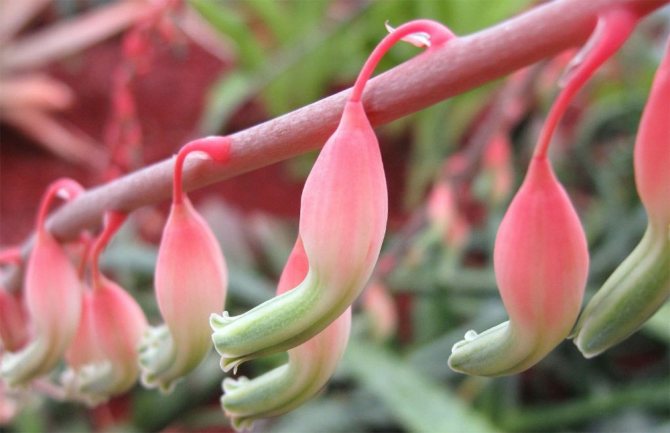

This is how Gasteria blooms
If you want seeds, shake the flower stalk from time to time to get the pollen on the stigma of the flower.
Important! During flowering, do not move the pot or change the ambient temperature.
After flowering, which ends by mid-summer, fruits remain in place of flowers - boxes with seeds. If the seeds are not needed, then the faded peduncle is simply removed.
The dormant period of the plant occurs in the autumn and winter months, with the exception of spotted gastria, which rests in summer. At this time, watering is reduced, the temperature of the content is reduced to 12-15 degrees and feeding is stopped.
Species diversity
The genus of Gasteria numbers within 70 varieties, which is associated with easy natural hybridization between species. At home, no more than 20 species are bred, which can be grown even by an inexperienced indoor plant lover.
The most popular types:
- Gasteria Armstrong - a compact plant with thick wrinkled marsh-colored leaves arranged in two rows, reaching a maximum of 10 cm in height. The edges of the sheet plate 6 cm long and 4 cm wide have a blunt shape. During flowering, orange-red flowers bloom.
- Gasteria warty - the species has narrow, rough, with pointed ends, leaf plates 20 cm long, covered with small white warts. Flowers pink or red with green blotches are located on a long peduncle of 80 cm.
- Gasteria keeled - the plant is distinguished by the arrangement of foliage in a spiral and the presence of a sharp keel on their underside. Almost smooth leaf, with the exception of a rough leaf and keel edging, is covered with few warts.
- Gasteria spotted - a species with a short stem, which is covered with dark green leaves with a mottled pattern. An almost smooth fleshy leaf plate with a slightly convex shape and a narrowed upper part reaches 20 cm in length. Intense red flowers bloom during flowering.
- Gasteria dwarf - the smallest variety, outwardly completely repeating the previous view. An adult specimen with dark green leaves with light spots and a border does not exceed a height of 6 cm. The flowers are pink.
- Gasteria Batesiana - the rosette of this species consists of dark green leaves 18 cm long, having a triangular-lanceolate shape and a smooth surface with numerous tubercles of light colors. The pink-orange flowers can be up to 4 cm long.
- Gasteria saber - stemless species with green shiny convex leaves that form a rosette. The length of the wide xiphoid leaf plate with the keel, covered with whitish warts, is 30 cm, and the width is 7 cm. During flowering, the plant throws out an arrow of 1 m with inflorescences of intense red flowers.
- Gasteria bicolor - a large representative of the genus with lingual leaves up to 30 cm in length has a larger rosette in comparison with other varieties. The dark green leaf blade is chaotically covered with white spots.
- Gasteria soddy - a species that does not have a stem, with arranged rows of dark green leaves of a slightly convex shape, which are strewn with small light blotches. The flowers are red or pink.
- Gasteria is whitish - a stemless variety with intense green wide xiphoid leaves, the length of which does not exceed 30 cm and the width is 7 cm.The rich red flowers up to 5 cm form a racemose inflorescence located on a long arrow of 1 m.
- Gasteria marble - view with spirally arranged leaves, folding into a socket. Luscious marble leaf plate is painted with silvery spots on a glossy green background.
- Gasteria triangular - a species in which, at a young age, the leaves are arranged in two rows, and over time they form a rosette. The length of the leaf plate, tapering from the middle and having a hard sharp spike of 3 mm at the end, reaches 20 cm.Its surface is replete with oblong light green spots, forming transverse stripes. Cartilaginous serrated margins and keel are light-colored. The plant blooms in pink.
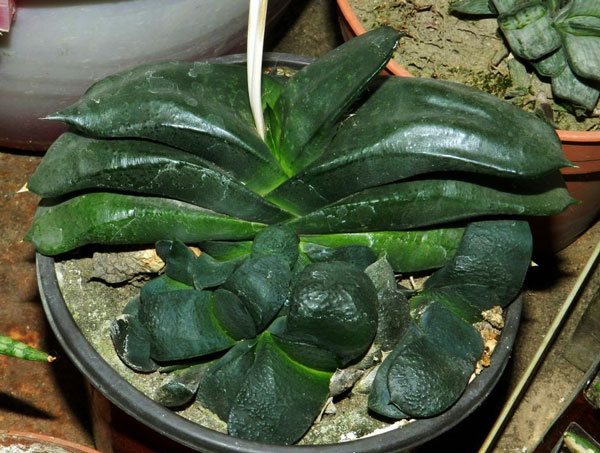

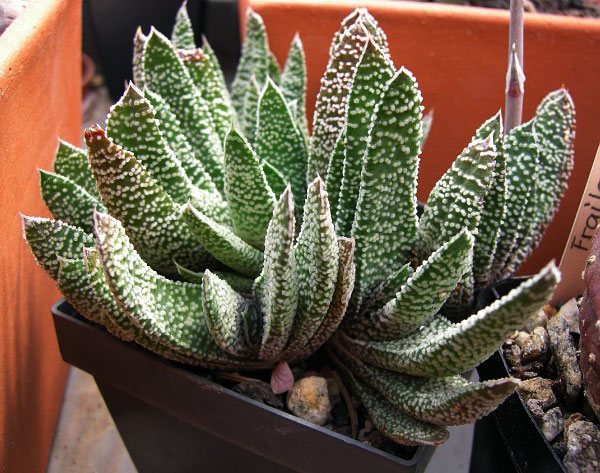

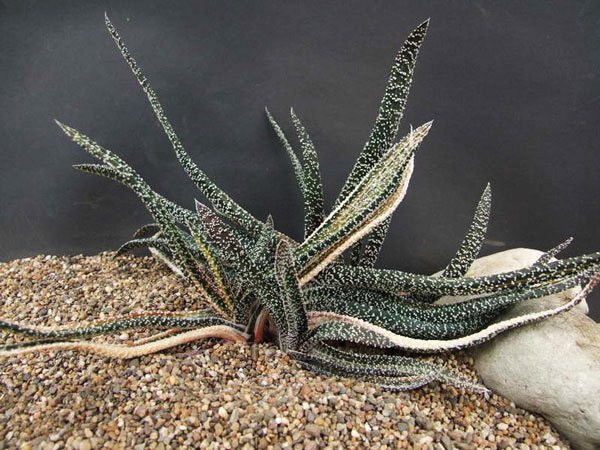

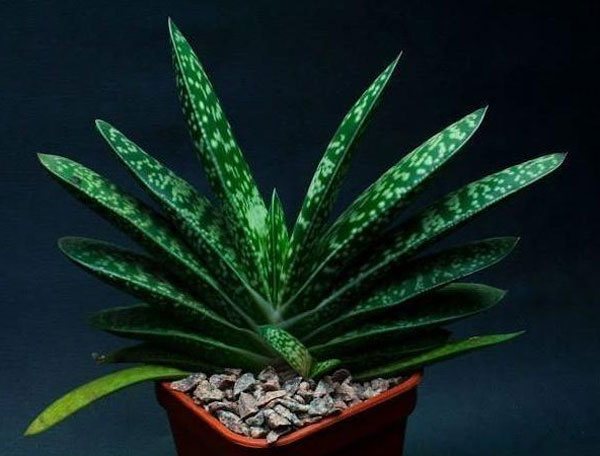







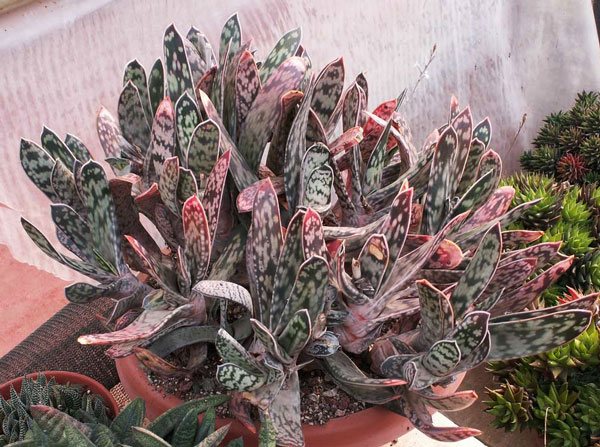

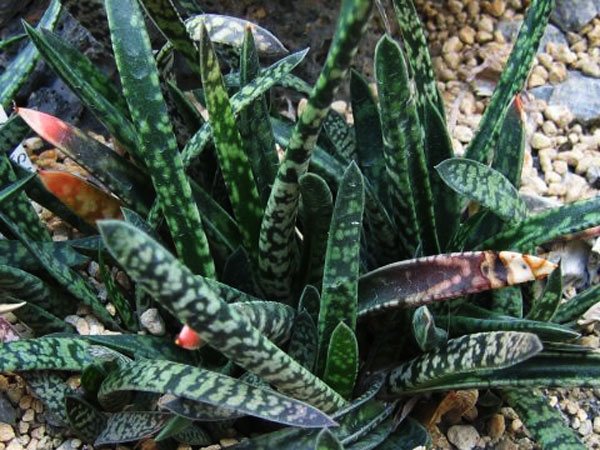

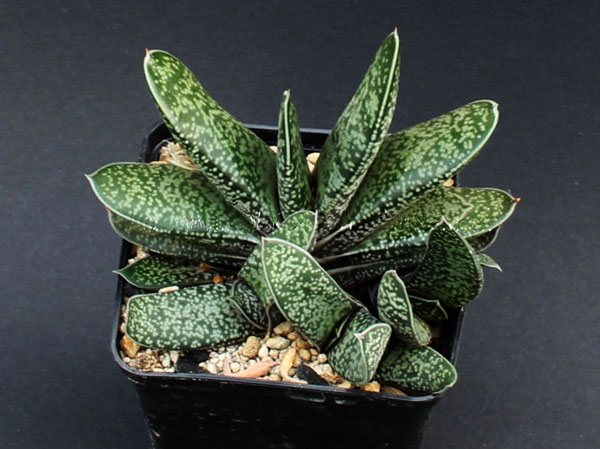

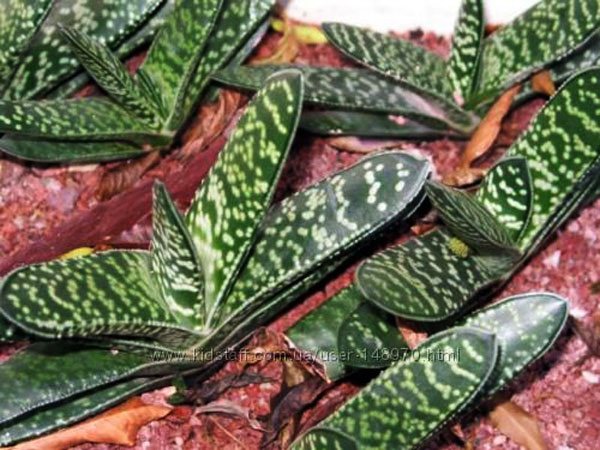



Most common home-grown species and photos of Gastria
No more than 10 types of gasteria are grown on windowsills. The following three types are most often found.
Gasteria verrucosa Haw. This succulent is the most popular among flower growers and most often found in their collection. Its leaves are strewn with white, wart-like bumps. The length of the leaves is 15-20 cm, the color is dark green, the shape is lingual, the top ends with a hard point. On the racemose inflorescence, flowers bloom pink-green or red-green. Peduncle and leaves grow from a root rosette. The leaves are very pleasant to the touch.
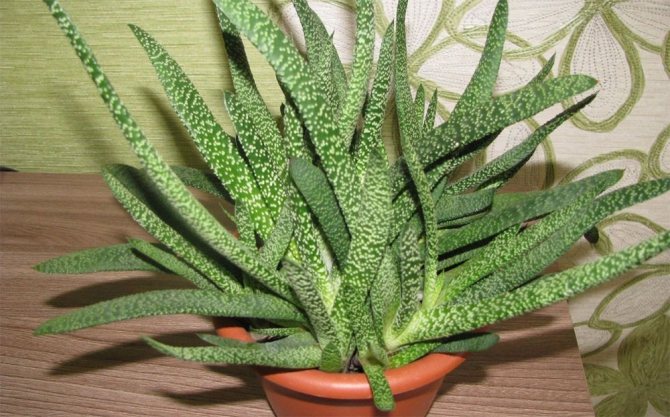

Photo. Gasteria warty
Gasteria carinata Haw. This type of gastria is characterized by the growth of leaves in a spiral. On the underside of the leaf there is a longitudinal bulge resembling a keel. Pimples are located only along the edge of the leaf, the rest of its surface is smooth.
Gasteria maculate Haw. Gasteria spotted does not have warts on the leaves; instead, the plant is decorated with stripes or spots. Moreover, stripes of different colors and shades can alternate - silvery, dark green and brown. The arrangement of the leaves is two-row or spiral. Its height is up to 20 cm.
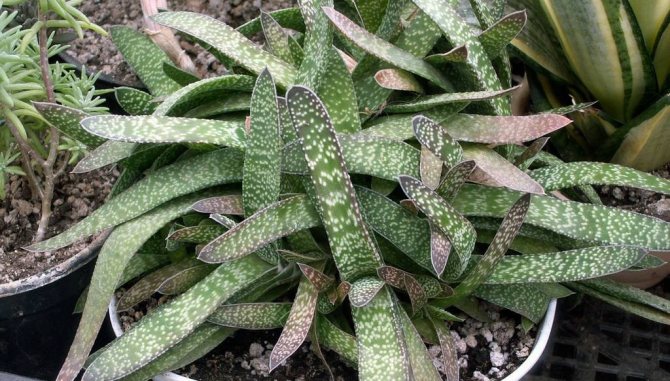

Photo: Gasteria spotted
Room care
Undemandingness is a characteristic feature inherent in any succulent, not excluding Gasteria.
Site selection and lighting
Light-loving plant does not accept direct sunlight... The bright sun becomes the reason for the loss of patterns on the leaves.
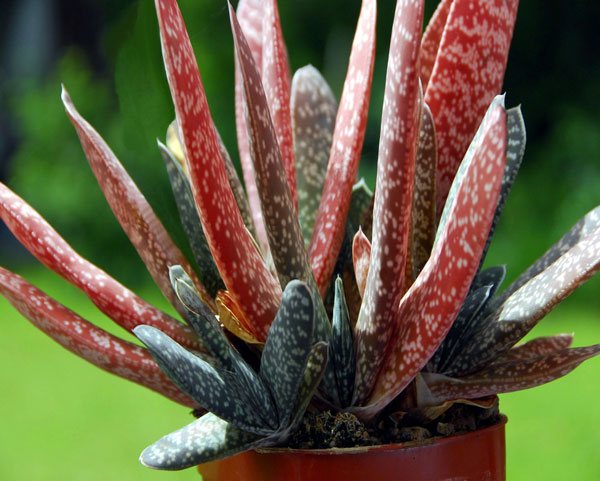

The best choice would be to place the pot on a windowsill on the south or west side of the house.
Attention! Gasteria develops well in light from an artificial source.
Temperature
According to the scientific literature, a culture needs a moderate temperature regime for successful growth. In theory, it should be 18-20 ° C in summer and 10-14 ° C in winter. In practice, the plant demonstrates excellent growth at home.
The main requirement for growing succulents in an apartment environment:
- in winter, place the pot away from heating appliances and closer to the window glass, protecting it from frosty air masses when ventilating;
- in the summer, move the flower to fresh air - a balcony, a loggia, a street.
Watering and humidity
The criterion for the summer need of a flower for watering is soil drying: excessive moisture is detrimental to the plant, as well as prolonged drying out. In the winter season, a succulent plant can do without moisture completely.
Advice! If it is hot in the apartment in winter, the flower should be watered every month.
The succulent plant is representative of the desert regions, therefore prefers rather dry airwithout the need for additional spraying. But would be grateful for a cool shower to remove dust from the leaves.
Bloom


Subject to the rules of complex care, the plant can please the owner with flowering.
In the spring or summer period, you can watch about 50 uniquely shaped flowers bloom one by one.
Attention! The possibility of flowering is excluded if the gasteria flower is located on the windows of the northern direction.
Priming
Any succulent substrate available in flower shops is suitable for plant cultivation.
If you wish, you can make a soil mixture with your own hands: mix leafy soil, peat and sand in a 2: 1: 1 ratio.
Advice! To increase the air and moisture permeability, a little brick granules should be added.
Top dressing
Fertilizers for succulents are applied every two weeks only during the growing season - from May to September. Top dressing is carried out by special complex fertilizers for succulents or cacti at half the rate... During the resting phase, the plant does not require additional nutrition.
Transfer
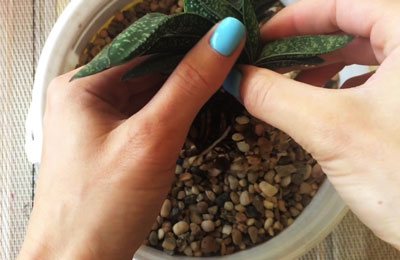

Despite its slow growth rate, succulent needs an annual transplant a little wider in the pot by means of transshipment while preserving the earth coma.
Before transplanting, which is carried out in spring or summer, the children are separated from the mother specimen.
Attention! The flower does not like large containers, it grows better in cramped pots, where there should be a drainage layer.
Reproduction
The optimal method for breeding gastria is the vegetative method - the separation of children or cuttings. The cut stalk, like the separated daughter socket, is dried and placed in the ground.


An experienced florist, if he has achieved flowering of a succulent, can try to use the seed method of reproduction, for which first it is necessary to carry out manipulations for pollination: shake the plant so that the pollen settles on the stigmas of flowers. After 2-3 months, when the seeds ripen, the following actions are performed with them:
- sown on well-moistened soil;
- covered with plastic wrap;
- organize regular ventilation;
- as it dries, the soil is moistened with a spray bottle;
- after growing up, the seedlings dive into the pots.
Methods for reproduction of the succulent Gasteria at home
Gasteria reproduces by seeds, leaves and babies
Gasteria can be propagated by seeds, leaf or daughter rosettes that you have after transplantation.
Seed propagation
The collected seeds should be scattered over the surface of the wet sand. They do not need to be sealed from above. The container is covered with foil or glass and left for germination. The temperature should be within 15-20 ° С, watering - spraying. Be sure to air the plantings by lifting the film or glass from time to time. The seeds will germinate for 1.5-2 months. Then the seedlings must be planted in separate containers. The next transplant is done only a year later.
Reproduction by "children"
This is a more effective and simpler way of breeding gasteria, allowing you to maintain varietal qualities. When transplanting gastria, young rosettes are separated. They should be immediately planted in separate pots that match their size.
Leaf propagation
Cuttings are also possible for gastria. For this, leaf cuttings are used. The leaf is cut and dried for 2-3 days. Then it is placed in soil for rooting.
Important! Planted cuttings are not watered! Watering can only be started 3-4 weeks after planting.
The difference between Gastria and Haworthia
The easiest of all these plants distinguish when blooming... The petals of the flowers of gastria are completely fused and are tubular. The havoria has a well-defined bent segment of the upper part of the petal, which has grown to half. Also, the young plant of Gasteria is distinguished by opposite leaves and large sizes, in comparison with the smallest succulent, the Hawortia.
This video details the differences between the three types of asphodelic succulents - aloe, haworthia and nasteria:
So, gasteria is not only an exotic flower, which, with minimal care, will delight the owner with a spectacular fan of leaves, but also a powerful amulet - so the signs say. And after the plant is in the bedroom, the owner will discover its beneficial properties, which are the ability enrich the room with more oxygen in nighttime.
Diseases, pests and plant growing problems
Unfortunately, the mealybug is not being fought with, since it is not excreted
The main disease-provoking factor is excessive watering of gastria.Then she is affected by fungal and bacterial diseases. If you follow the watering rules, nothing threatens your pet.
Pests attacking Gasteria are mealybugs, scale insects and spider mites. They fight the scabbard with the help of insecticides, they don't fight the mealybug in any way - it is not displayed. It remains only to get rid of the diseased plant. Leaves affected by spider mites must be cut out immediately.
When Gasteria is overdried (poor watering), the leaves begin to turn yellow, dry and die off. This does not mean that she is dead. She has a living root system. You just need to cut off the dried leaves and adjust the watering.
Hypoesthesia flower and home care for it.
If you love cacti then check out Mikhanovich's hymnocalycium, for more details follow the link
How to care for Gasteria?
This house plant is recommended for beginners to master the basics of flower business. Gasteria is easy to care for and requires only minimal procedures to grow and delight the owner. But, you still need to take care of the pet, taking into account her needs.
Choosing the right place
Gasteria needs sunlight, so it is better to put a pot with this plant on a window located on the southeast or southwest side. The correct location of the flower is half the battle, as the following mistakes can ditch the succulent:
- Gasteria is harmful to direct sunlight. Typically, in its natural environment, this small plant is hidden by larger, spreading shrubs. With an overabundance of light, its leaf plates lose their original patterns.
- It is necessary to protect the flower from cold and drafts - they can cause the death of a thermophilic succulent.
- All types of cacti can be neighbors for Gasteria, it will grow well in such an environment.
Temperature regime
The most suitable air temperature for this flower is + 22 ° - + 25 ° C. However, lowering the indicator to +12 ° С is not critical. Heat from heating devices that work intensively in winter can cause more damage to the plant. If you provide the ward with coolness, for example, by moving the pot closer to the cold glass, then after a period of rest, the gasteria will begin to bloom profusely.
It is useful for a succulent to receive fresh air, so it is recommended to ventilate the room, excluding direct draft.
About moisture and watering succulents
If a flower is able to store moisture, this does not mean that it does not need regular watering. In winter, 2 procedures per month are enough for him, in other seasons - once a week. When watering, it should be borne in mind that the soil must not completely dry out.
The gasteria plant is a resident of desert regions, therefore, it practically does not react to air humidity and you can not regulate this indicator. When leaving, you can focus on the following principles of growing succulents:
- The period of active growth and development of the plant begins with the arrival of spring and lasts on average until the end of October. At this time, it needs regular watering, drying out of the soil should be avoided.
- During the flowering period of gastria, it is recommended to arrange "rest", the number of watering is reduced.
- You can sometimes arrange a shower for the flower, cleaning the foliage from dust and dirt, but you need to do it very carefully - not flooding the flower. Another nuance - if you irrigate a succulent in the sun, burns may appear on its delicate leaves.
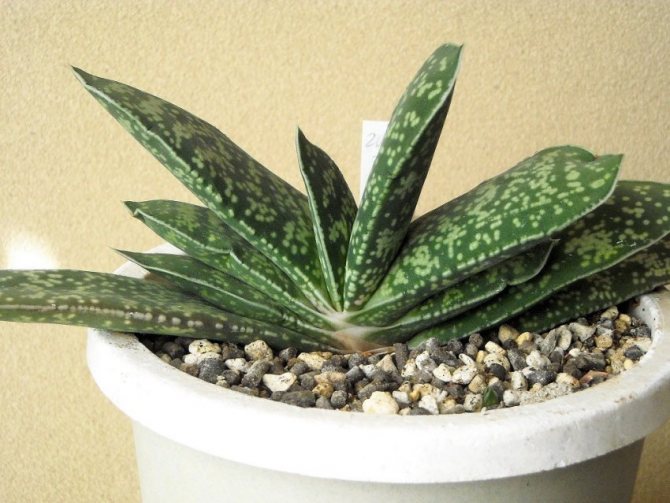

Suitable soil
For this green dweller, ready-made soil for cacti and succulents, which can be purchased at any specialty store, is excellent. As a rule, it is prepared based on the needs of these plants: it has a loose consistency, contains little nitrogen, is low in nutrition and does not retain moisture. Given these features, you can make a soil for gastria with your own hands by mixing garden soil with sand, which has large fractions. The most suitable mixture is:
- 3 pieces of leafy land;
- 5 parts of sod land;
- 2 parts of peat;
- 4 pieces of sand.
All succulents and the gasteria flower are no exception, they need good drainage. To do this, the pot can be filled by a quarter with brick chips, expanded clay, perlite or fine gravel. The container should also have drainage holes through which moisture can evaporate and the air necessary for the breathing of the root system to penetrate.
Top dressing
It is recommended to fertilize the succulent in the summer, when flowering time comes. The best fertilizing is cactus fertilizer. The features of feeding gastria are as follows:
- fertilizers are introduced from May to early autumn;
- using cactus feed, it is recommended to slightly reduce its concentration;
- feed Gasteria enough once 2-3 weeks;
- you should be careful with nitrogenous fertilizers, if you feed a succulent like ordinary leafy flowers, then there are risks of root rot; this flower needs nitrogen, but in small quantities.
It is important! Organic fertilizers - manure, bird droppings and others are not suitable for succulent plants, as they contain a large amount of nitrogen.
Photo gallery
In some specimens, such growths form into stripes. The upper part of the sheet has a corrugated shape.
Gasteria Armstrong. As you can see from the photo, this type of gasteria outwardly has a significant similarity with aloe, but it has a relatively small size:
Photo gallery
The tips are pointed, but sometimes they can also have a rounded tip. In some species, the surface of the leaves is rough, but in most it is smooth and glossy.
Site selection and lighting
It is recommended to place a gasteria flower on the east, west or south window, but with the obligatory shading from the midday sun. It will grow beautifully on the north window, but will refuse to bloom.
In winter, it is important to provide Gasteria with the brightest spot in the room. The plant needs frequent ventilation.
It is important to know that it does not tolerate drafts well. In summer, it is useful to take Gasteria out into the fresh air, providing it with shading and protection from rain.
The optimum temperature for gastria in summer is 18 to 25 ° C, and in winter 10 to 12 ° C, but not lower than 6 ° C
A cool temperature in the cold season is an important condition for abundant flowering in summer.
Photo gallery
At the base of the bush, the leaves are more voluminous than at the ends. The leaves grow in pairs in opposite directions. The main part of the plant is three pairs of leaves, all the other buds lie on the ground one above the other. The inflorescence is a solitary raceme 4-5 centimeters long, and the peduncle is only 5-6 mm long.
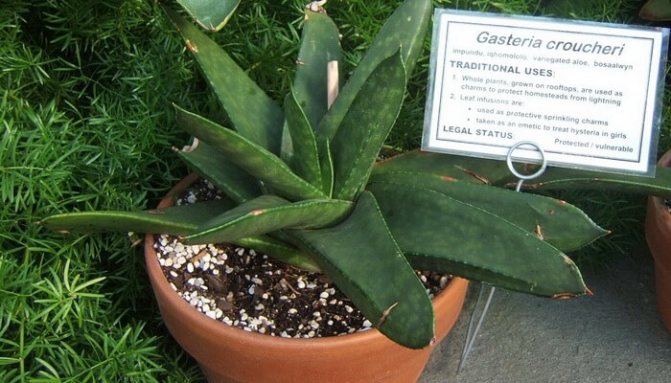

Gasteria Crowchery. This species is very easy to grow. The leaves are juicy and fleshy. The plant is very short - it does not grow higher than 4 cm, but can form clusters of up to 8 bushes.
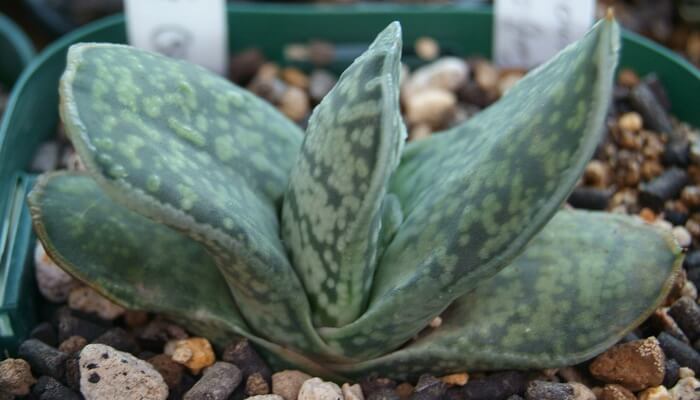

The leaves grow in a rosette shape and taper towards the center. Their length does not exceed 2 - 3 cm. The inflorescences are pink with greenish ends of the petals.
Photo
Gasteria Armstrong:


Sod Gasteria:


Gasteria spotted:
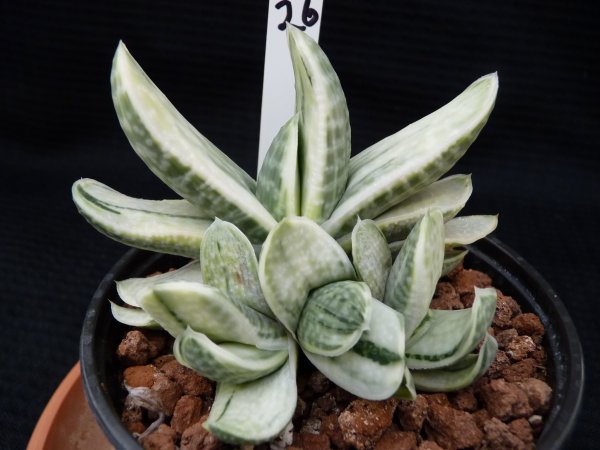

Gasteria is whitish:
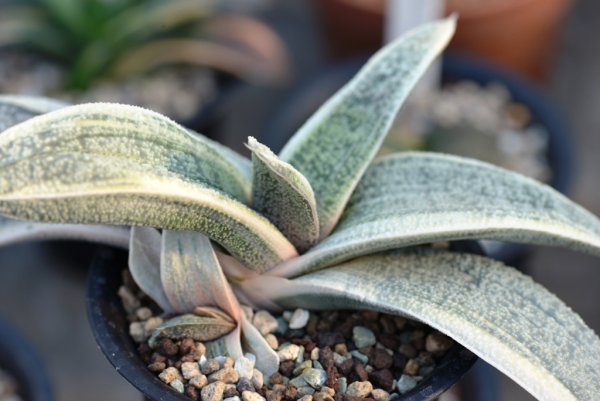

Gasteria warty:


Temperature
The optimum temperature for growing warty gastria at home is not lower than +22 degrees. The pot should not be placed in the immediate vicinity of heating appliances.
You can grow a plant at a temperature of at least +12 degrees. If the temperature drops below this indicator, then Gasteria may die.
It is advisable to place the Gasteria pot in a well-ventilated area, since the plant does not like stuffiness. The room needs to be periodically ventilated by opening the windows wide open and removing the flower while airing in another room.
Reproduction
The most convenient reproduction is the separation of daughter rosettes or rooting of cuttings... The stalk or rosette is first dried, then planted in the ground.
You can also try growing from fruits that have grown in place of flowers. Seeds are sown on moist soil and covered with foil.
Periodically you need to ventilate and spray the ground. Seeds take a long time to germinate, so be patient.
After germination, the seedlings are dived and transplanted into a suitable pot.
Watering and humidity
The main thing to remember is that you cannot fill the plant, otherwise it will die. If the soil of the flower has not yet dried up after the last watering, then it is not necessary to water it again. In winter, you do not need to water Gasteria at all, but sometimes you can water it at least once a month. But if the house is hot, then make sure that the earth does not dry out. In the summer, you need to water more often, not flooding, but wait until the earth dries out. And you can not spray the leaves in the sun, so that burns do not appear. Since Gasteria is a desert plant, it does not require high humidity in the room. Therefore, it is not necessary to spray it. Sometimes it is enough to wash it under the shower to wash off the dust from the leaves.
Useful properties of gastria


Gasteria is warty. Photo


Gasteria is spotted. Photo
In indoor floriculture, gasteria is valued not only for its decorative qualities, but also for its ability to filter air and absorb carbon dioxide from it, as well as various harmful impurities. And this plant also emits a large amount of oxygen during photosynthesis, so it is recommended to place it, for example, in bedrooms.
Requirements for the conditions of detention
Osteospermum choose an annual or perennial culture
Gasteria is considered an unpretentious houseplant suitable for beginner hobbyists. However, it is possible to achieve flowering of gastria only in favorable and comfortable conditions for it. In general, caring for this indoor flower is not difficult. Observing basic rules, you can maintain its good condition for many years.
Lighting
Gasteria feels comfortable both in the shade and in the sun. It can be taken out in the summer under the open sky, it is not afraid of the bright sun. However, excessive lighting in spring and early summer can lead to sunburn and discoloration of the leaves - they turn burgundy red. By autumn, Gasteria restores the color of the leaves.
This plant feels much more comfortable in conditions of good lighting and diffused light. Artificial light tolerates well. The most favorable places for Gasteria: southern, southeastern or southwestern windows in the apartment.
Temperature
Room temperature (20-23 ˚C) is natural for this succulent. It responds to a decrease in temperature below 18 ° C by a slowdown in growth. In winter, at home, it is necessary to protect the plant from drafts - to remove it from the window during ventilation, and also not to place it near heating devices that instantly dry out the soil.
Photo gallery
Succulent transplant
Since Gasteria grows very slowly, replanting is often unnecessary. A transplant should be carried out only in cases where the plant becomes cramped in a pot or it was originally planted in an unsuitable container. It is best to transplant a flower in the spring months and no more than 1 time in 2 years.
For transplanting, you need to prepare a spacious pot, drainage and soil. You need to fill the drainage into the pot, and then move the warty Gasteria into it along with the earthen lump. It is advisable to tamp it from above by adding a small amount of soil. It is also recommended to separate when transplanting young children in order to slightly accelerate the growth of gastria. It is undesirable to transplant the flower immediately after purchasing it, provided that the pot is spacious enough.
Soil and fertilizers
It is advisable to plant the succulent in a special soil substrate that is intended for cacti. You can buy it in specialized stores.You can prepare the substrate yourself by mixing parts of the turf and leafy soil with garden soil and a small amount of peat and sand. The bottom of the pot must be covered with drainage and a mixture of fine gravel and broken brick.
To feed the plant, special fertilizers designed for cacti are suitable. The concentration of such fertilizer for warty gastria should be 2 times less than for a cactus. It is necessary to carry out top dressing only in the summer season.
Reproduction of gastria by offspring and seeds
Reproduction of the Gasteria plant can occur by offspring and seeds, while the first method is simpler and more reliable, therefore it is used much more often. In order to get seeds, it is necessary to carry out additional manipulations with pollination of flowers.
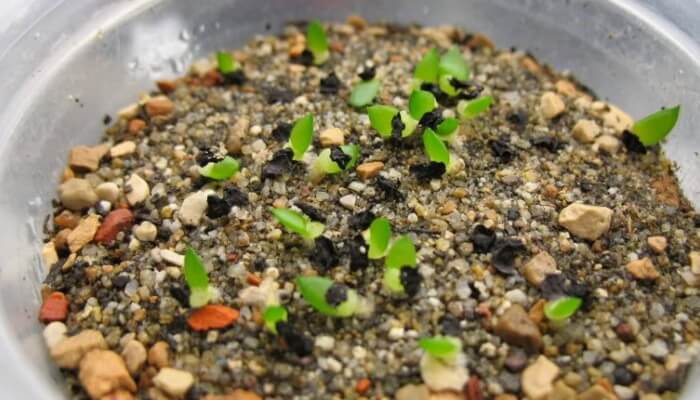

The seeds begin to ripen in mid-summer. If they are not needed, the flower can be plucked so as not to tire the plant unnecessarily.
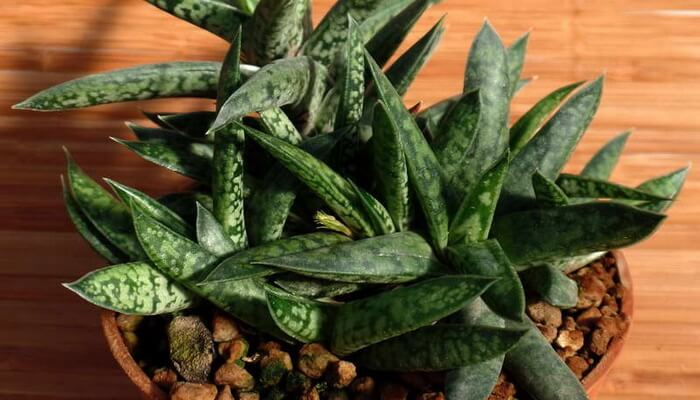

It is necessary to reproduce by children in early spring, when the plant is just emerging from the sleep stage and gaining strength. After that, rooting is best. After rooting has occurred, the flower needs to be watered more often than older specimens. At first, a new plant can develop rather slowly, but with proper care, flowering will begin in 2 years.


